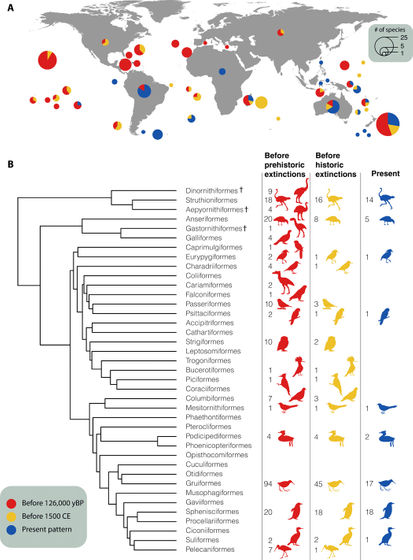Research results show that there were four times as many 'birds that cannot fly' in the world without humans

by
A study published in December 2020 by biologists at University College London (UCL) in the United Kingdom found that 166 species of 'flightless birds' had been destroyed by humans in the last 120,000 years. I did. In contrast, there are only 60 species of flightless birds in existence, so researchers point out that 'if humans were not driven to extinction, there would be four times as many flightless birds in the world as they are now.'
Anthropogenic extinctions conceal widespread evolution of flightlessness in birds | Science Advances
https://advances.sciencemag.org/content/6/49/eabb6095
Flightless bird species at risk of extinction | University of Gothenburg
https://www.gu.se/en/news/flightless-bird-species-at-risk-of-extinction
Flightless birds more common globally before human-driven extinctions | UCL News --UCL – University College London
https://www.ucl.ac.uk/news/2020/dec/flightless-birds-more-common-globally-human-driven-extinctions

To investigate the effects of human activity on the evolution of birds, researchers at UCL and Gothenburg University in Sweden have collaborated to comprehensively cover birds known to be extinct from the rise of humans to the present day. I scrutinized it. As a result, 581 species of extinct birds have been identified from the
Then, when the research team investigated the ecology of extinct birds from fossils and records, it was found that 166 species, which is about one-third of the 581 extinct species, were incapable of flying. Adding 60 existing flightless birds to these 166 species gives a total of 226 species, so the research team said, 'If you add the artificially extinct 581 species to the number of existing birds in the world, the whole That's a 5% increase, but the number of flightless birds will increase fourfold. '
The following shows the distribution (top) and lineage (bottom) of flightless birds: 'Species extinct between 126,000 years ago and 1500 AD (red)' and 'Species extinct after 1500 AD (yellow)' It is a color-coded figure by 'existing species (blue)'. The survey revealed that not only were 581 species of birds extinct, but 85 birds of different families had disappeared altogether.

According to Ferran Sayol of Gothenburg University, the lead author of the study, birds often lose their ability to fly in environments where there are no predators, such as small islands. By abandoning flight capabilities in the process of evolution, birds can allocate the energy they had previously devoted to flying to something else. However, this also led to the result that 'it is easily extinct by humans and alien species such as cats and mice brought in by humans.'
The following shows the ratio of existing species (blue) and extinct species (orange) divided into all species (left), those inhabiting the continent (center), and those inhabiting the island (right). The proportion of extinct species in the upper flightless birds is 3.7%, while that in the lower flightless birds is 73.5%, which shows how easy it is for flightless birds to become extinct.

'This study shows that the evolution of birds into flightless birds is a more widespread phenomenon than previously thought, and that living non-flight birds are now alive. There are only 12 families of penguins, ostriches and quinas and their relatives, but previously there were at least 40 families. If we do not destroy these birds, we will not fly with owls, tokis and foxes. I should have shared it, but sadly everything has disappeared. '
Related Posts:







